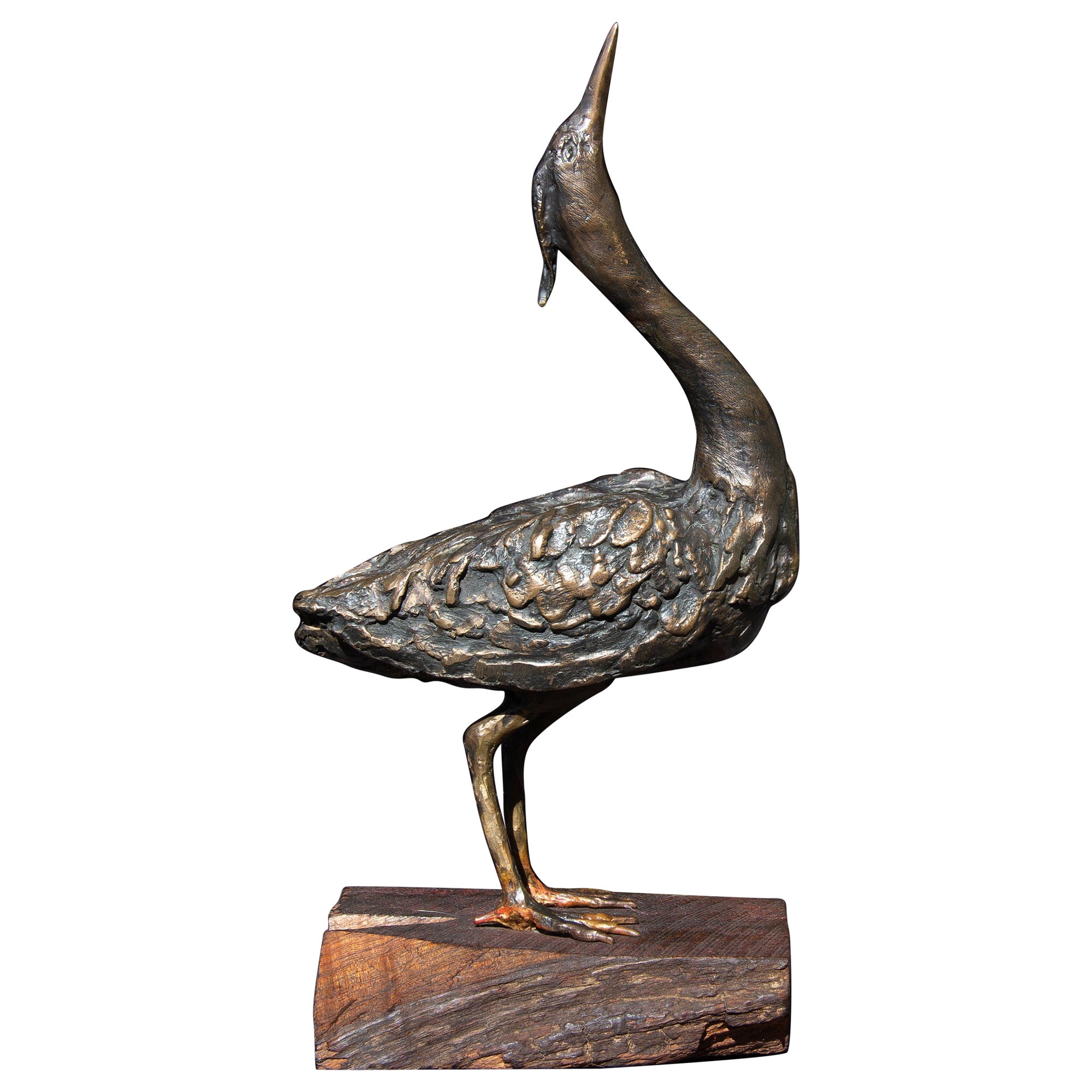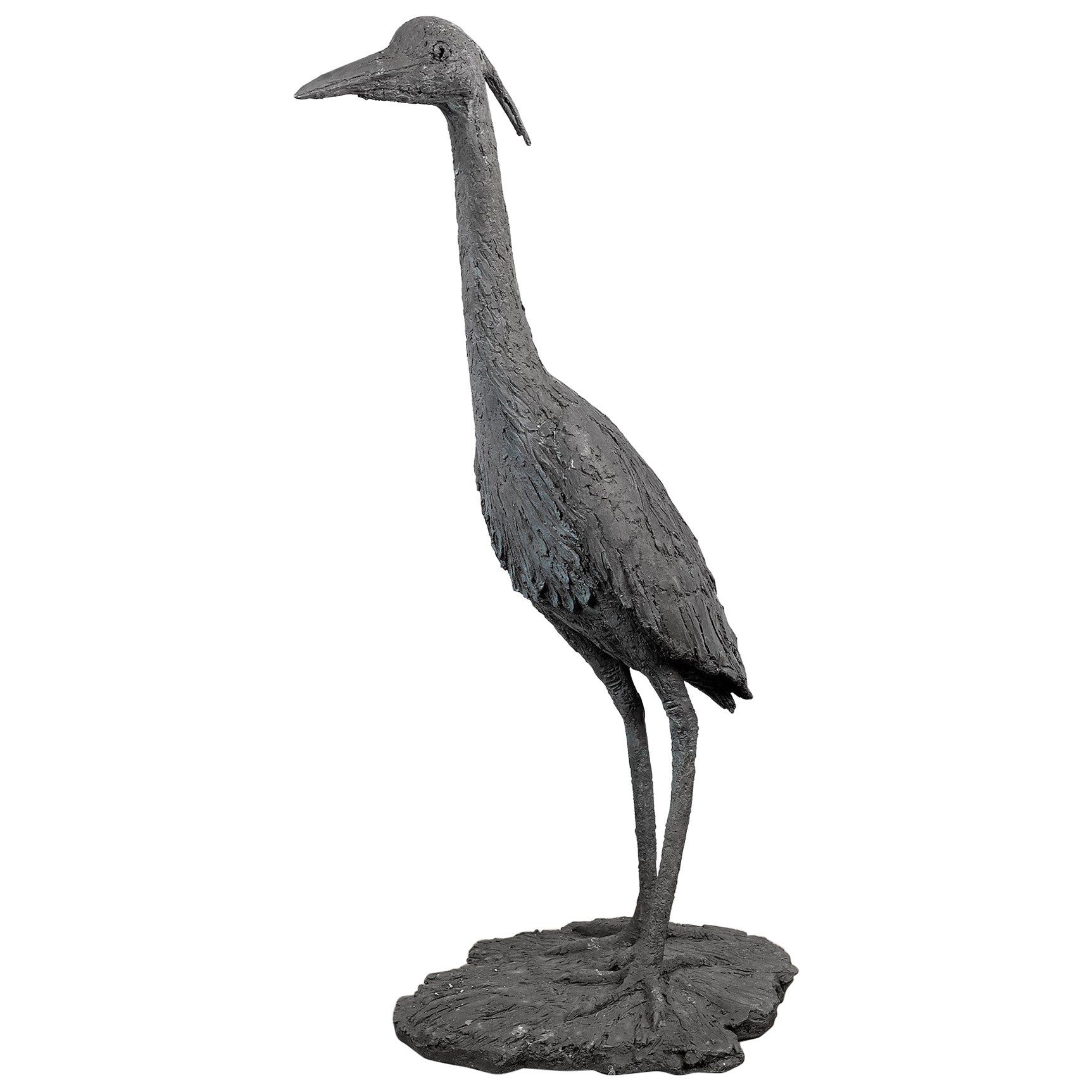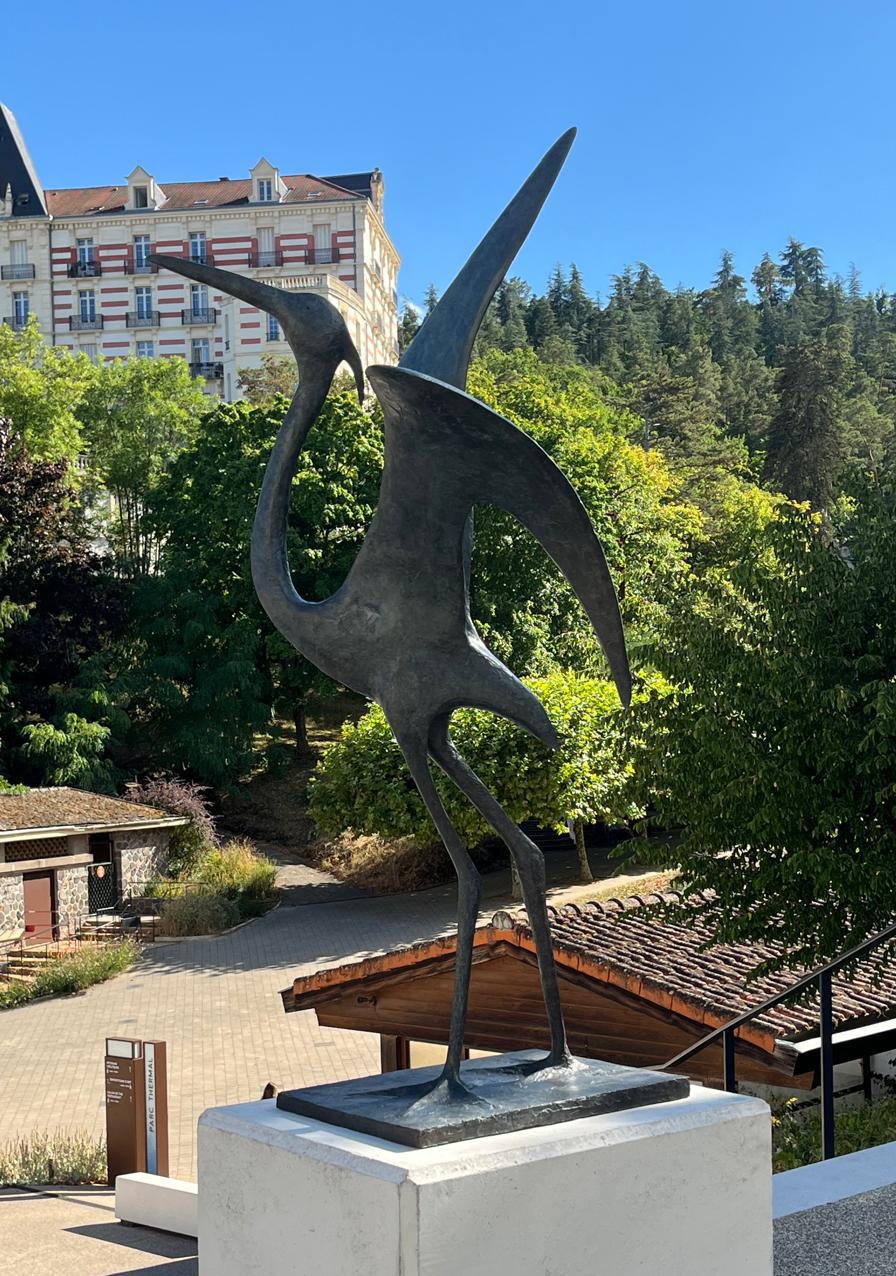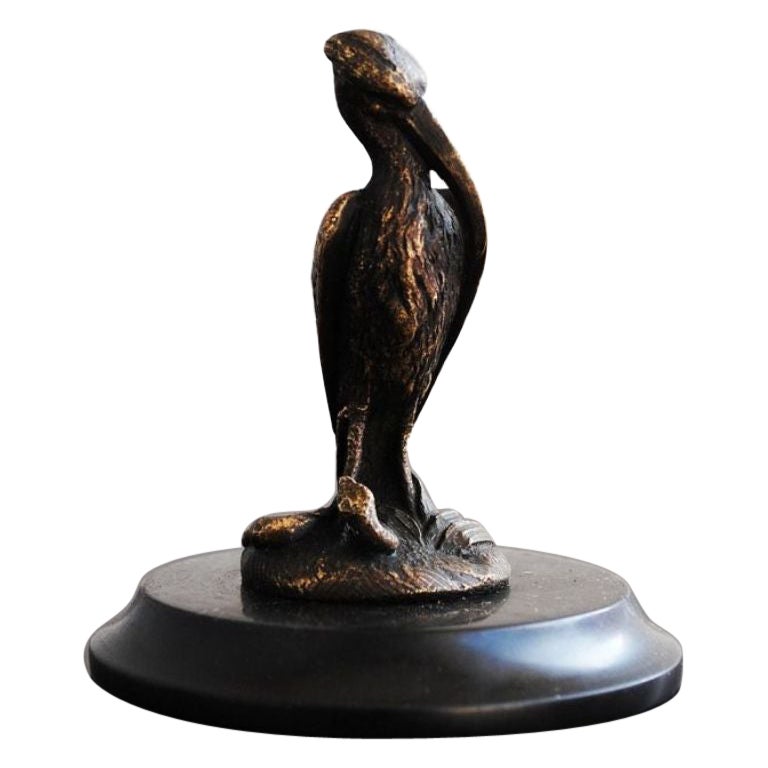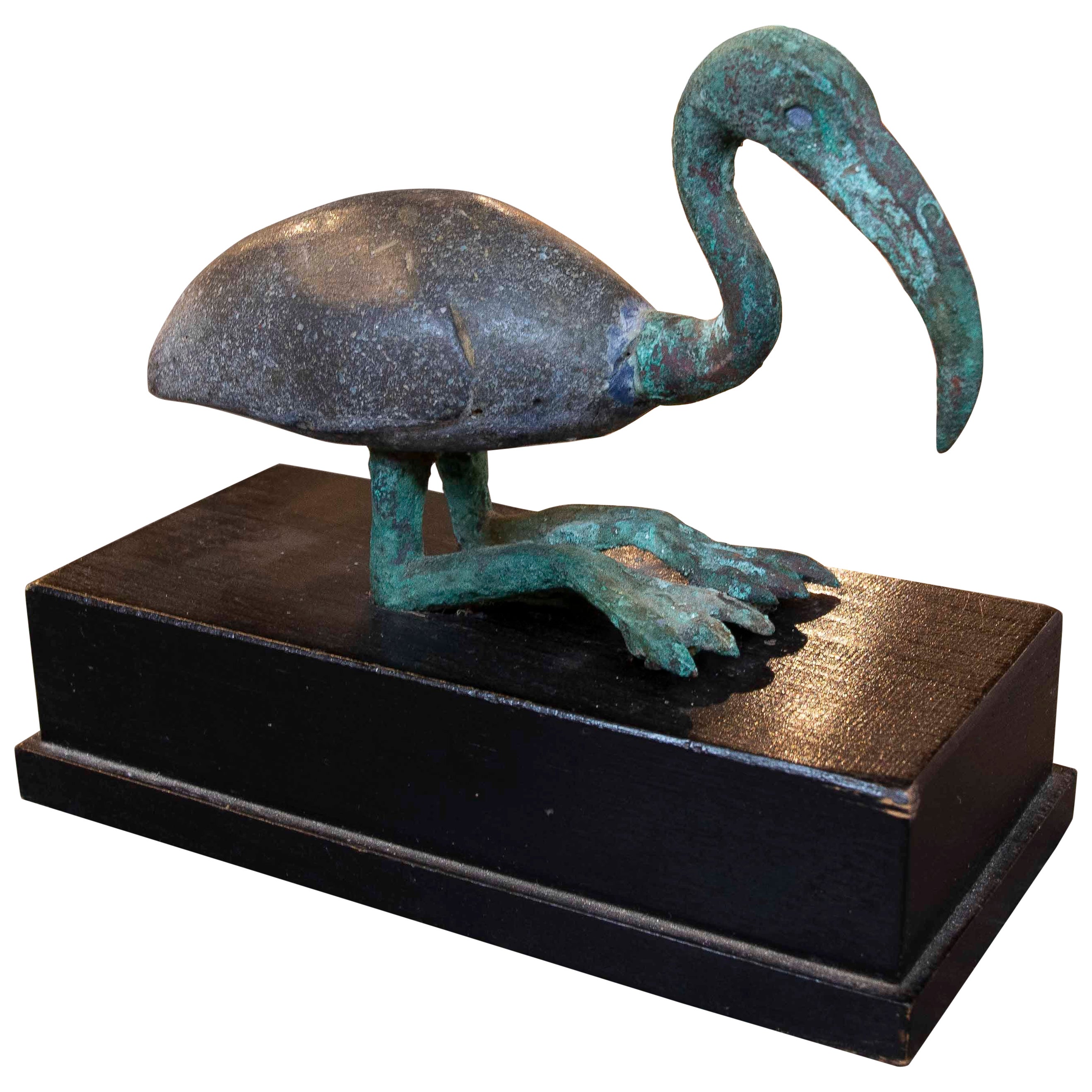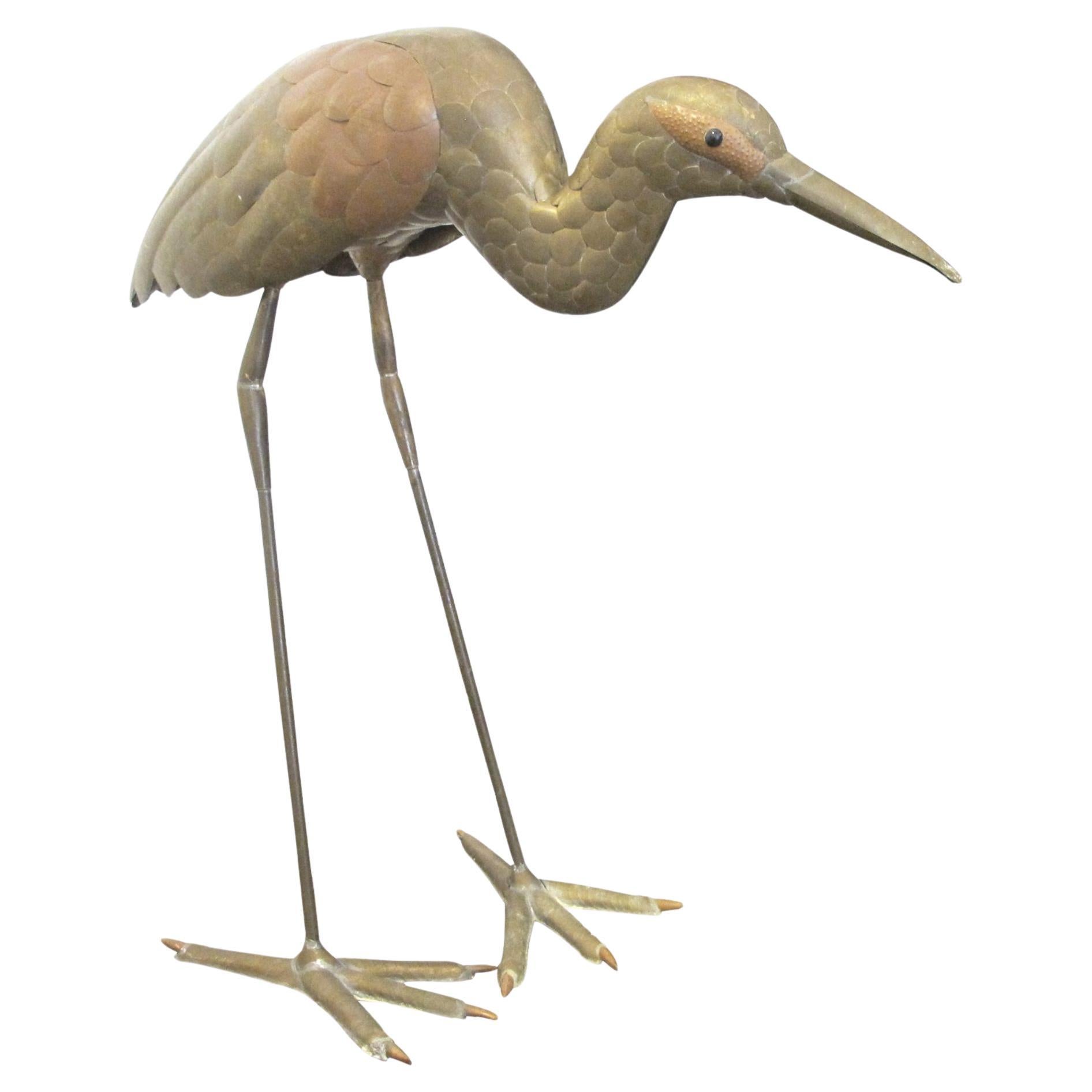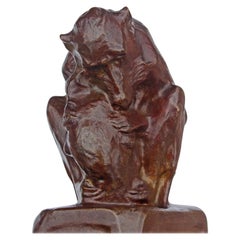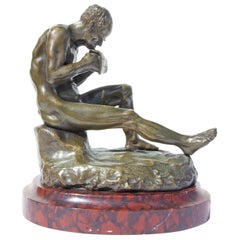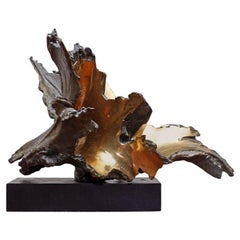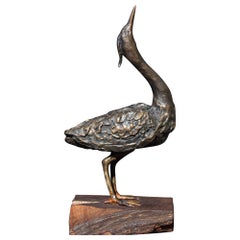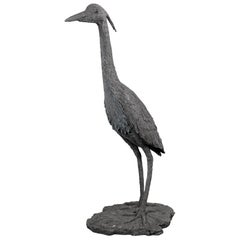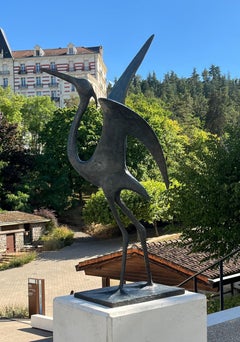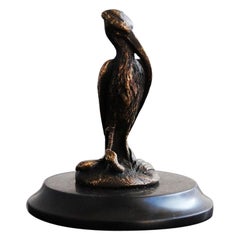Items Similar to Bronze Heron Sculpture by Wayne F Williams
Want more images or videos?
Request additional images or videos from the seller
1 of 10
Bronze Heron Sculpture by Wayne F Williams
$750
£565.57
€654.11
CA$1,052.25
A$1,169.64
CHF 613.10
MX$14,284.10
NOK 7,654.18
SEK 7,201.16
DKK 4,882.12
About the Item
Bronze heron by American sculptor Wayne Williams. Signed and dated 1993. Edition 2/2. Mounted on a walnut base.
From Finger Lakes Magazine 2001:
Art is everywhere in the Finger Lakes. Inspired by the region’s diverse scenery and lifestyles, artists pursue their creativity outdoors, in studios and in workshops. In the many well-established museums and galleries or at the newer fledgling arts organizations, a wide array of artistic styles and talents are represented. Often the artists, like Wayne Williams, share their artistic skill and passion through teaching at local colleges.
Williams, who is retired after a 35-year career at Finger Lakes Community College, found his calling there. “I didn’t want to teach in public schools,” explains Williams of his career choice. “I wanted to be at the college level. CCFL (the Community College of the Finger Lakes, as it was then known) was literally creating a college, right from scratch.” The year was 1968 and Williams was charged with coordinating the new college’s art program.
Rand Darrow, a CCFL student in that first year, remembers attending Williams’ art classes in a commercial building on Main Street just south of the railroad tracks in Canandaigua. Darrow appreciated his instructor’s relaxed manner. “He was a great teacher,” recalls Darrow, “cracking jokes all the time.” Darrow graduated with a major in Liberal Arts and continued on to SUNY Oswego where he earned a BA in fine arts. He taught art to elementary and middle school students for 30 years.
These days Williams and Darrow typically cross paths at the Wayne County Arts Council in Newark where Williams and his wife, Marleen, are heavily involved. Williams offers classes in figure drawing and sculpture and hangs the gallery’s shows, including his former student’s “Slavic Tales of Novgorod” this past August. “I’d like to take a sculpture class from him,” says Darrow.
In 2003 when Williams retired, the college honored him and another retiring art professor, Tom Insalaco, by renaming its art gallery the Williams-Insalaco Art Gallery. It was known formerly as Gallery 34 to recognize its origins at 34 North Main Street in Canandaigua. Williams held professor’s rank from 1976 and served as director of the art gallery beginning with its opening in 1983.
Williams, who was born and raised in Newark, New York, says he began doing art at about age 8. By the time he was in junior high school his career direction seemed clear. He received local and national awards for his art and a scholarship to Syracuse University, from which he graduated in 1958 with a Bachelor of Fine Arts in sculpture. He continued with graduate work at Syracuse, receiving an MFA in sculpture in 1962. He worked full time as a sculptor until he began teaching.
At one point Williams admits he wanted to be a painter, but didn’t want to adopt the abstract expressionist style in vogue in the 1950s, preferring to pursue the realist tradition. He advises any would-be artist to “do what you do because you love it.”
After graduation he traveled abroad, spending time in Belgium, the land of his ancestors. “My family’s name was originally Willems,” explains the 73-year old who still relishes the time spent in the Flemish countryside. Williams speaks excitedly about art, referencing the lives of great artists. He acknowledges that American artists do not have the same stature as those in Europe, where Old Masters like Brueghel and Rembrandt are national heroes.
These days the energetic Williams, known primarily as a sculptor, is active at the Phelps Arts Center where he is on the board of directors. In mid-September when a group of visitors on a motor coach tour explored artworks displayed in the beautiful church-turned- gallery, they were treated to a large number of Williams’ bronze and metal sculptures, along with his charcoal drawings. “I’ve always loved his work because he deals with things, people, and animals you understand,” says the center’s Director Emeritus Marion Donnelly, who has known him for many years.
Outside the Phelps Community Historical Society, Williams’ life-size figure of a farmer raises his pitchfork above a colorful flower garden on the front lawn. Inspired by the peasants working the fields in Europe, the metal figure is shown with wooden shoes. This is Williams’ largest copper piece, loaned to the Phelps museum in connection with Artistry in Sculpture, a community exhibition in 2009. Williams added a new base using a metal wagon wheel, and topped the figure’s head with a cap.
“We always have referred to him as a ‘farmer,’” says Mary Beth Springmeier, director of the historical society. The work pays homage to the farmers who dominated the agricultural history of Phelps. “Many came across from Europe, including the Netherlands and the Lowlands,” explains Springmeier.
Williams readily admits he is influenced by artists like Millet and Van Gogh, both 19th century painters whose images ennobled the laboring peasant. There were farmers on both sides of Williams’ family and his familiarity with a grandfather’s farm horses is reflected in his realistic rendering of animals.
Williams’ themes vary: bronze sculptures of a cat sleeping on a chair or a nun riding a bicycle demonstrate he cannot be pigeon-holed. In Rochester’s Highland Park, the Vietnam Veterans Memorial includes a figure of a soldier sculpted by Williams. His work is found in many public and private collections and even one local school. A few years ago he created “Cougar” for the North Rose-Wolcott Central School where his figural sculpture, “The Graduate,” was previously installed striding across the courtyard at the high school. Before casting the school’s feline mascot in bronze, Williams created two models. What he calls a more pensive cougar was chosen over a springing pose. Kathy Hoyt, the school’s athletic director, recalls how the student club, the Student Athlete Mentors, raised most of the money for the sculpture through a variety of fundraisers.
Williams’ newest piece, “Sal Pulling,” was created for the September exhibition, Waterway West: A salute to the Erie Canal at Rochester’s Oxford Gallery, an arts business that represents him. The exhibit was planned for the 2010 World Canal Conference held in the city. “I researched mules,” explains Williams, who presented the animal straining forward, pulling the weight of an unseen canal boat. The sculpture’s welded steel frame was covered with copper and then hammered. Later, hot bronze was applied to the surface.
“Mules became the preferred power for the canal,” says Williams. “Pound for pound a mule is stronger than a horse and more sure-footed.”
Williams learned they are extremely intelligent animals and can jump higher than a horse. This attention to detail prepares him for his realistic depiction of the animal.
“I named the mule Sal,” admits Williams, referring to the classic local song, 15 miles on the Erie Canal.
- Dimensions:Height: 17 in (43.18 cm)Width: 8.5 in (21.59 cm)Depth: 6.75 in (17.15 cm)
- Materials and Techniques:
- Place of Origin:
- Period:
- Date of Manufacture:1993
- Condition:Wear consistent with age and use.
- Seller Location:Rochester, NY
- Reference Number:Seller: 648011stDibs: LU1585240135692
About the Seller
5.0
Vetted Professional Seller
Every seller passes strict standards for authenticity and reliability
Established in 1979
1stDibs seller since 2015
542 sales on 1stDibs
Typical response time: 11 hours
- ShippingRetrieving quote...Shipping from: Rochester, NY
- Return Policy
Authenticity Guarantee
In the unlikely event there’s an issue with an item’s authenticity, contact us within 1 year for a full refund. DetailsMoney-Back Guarantee
If your item is not as described, is damaged in transit, or does not arrive, contact us within 7 days for a full refund. Details24-Hour Cancellation
You have a 24-hour grace period in which to reconsider your purchase, with no questions asked.Vetted Professional Sellers
Our world-class sellers must adhere to strict standards for service and quality, maintaining the integrity of our listings.Price-Match Guarantee
If you find that a seller listed the same item for a lower price elsewhere, we’ll match it.Trusted Global Delivery
Our best-in-class carrier network provides specialized shipping options worldwide, including custom delivery.More From This Seller
View AllBronze Sculpture "Mother and Child" Baboons
By Blanca Will
Located in Rochester, NY
"Mother and Child" an impressionist bronze sculpture of baboons by sculptor Blanca Will, American, 1881-1978, dated 1912. Works by Will are rare.
Blanca Will Exhibited at the Nationa...
Category
Early 20th Century American Modern Animal Sculptures
Materials
Metal, Bronze
Large Modern Giraffe Sculpture, American, Mid- Century
By Manuel Carbonell
Located in Rochester, NY
A large and early sand cast aluminum Modernist sculpture of a giraffe by Cuban American artist Manuel Carbonell. Pedestal included. Height is 73” with base. Presented by Joseph Da...
Category
Mid-20th Century American Modern Animal Sculptures
Materials
Metal, Aluminum
19th Century Bronze Sculpture "The Letter"
Located in Rochester, NY
Antique bronze sculpture of man reading a letter or proclamation. Marble base, 19th century. Unsigned.
Category
Antique 19th Century European Figurative Sculptures
Materials
Bronze
Bronze Sculpture "Furnace Flowers" 1963 Mid Century Modern Francesco Somaini
By Francesco Somaini
Located in Rochester, NY
Bronze sculpture Polished and patinated bronze sculpture. "Furnace Flowers" by mid century modern Italian sculptor Francesco Somaini (Italy 1926-20...
Category
Mid-20th Century European Modern Abstract Sculptures
Materials
Bronze
Bronze Statue Elephant and Her Calf by American Sculptor Dan Ostermiller
By Dan Ostermiller
Located in Rochester, NY
Poignant bronze sculpture of nurturing mother elephant and her calf. Rich brown patina with hints of verdigris. By American sculptor Dan Ostermiller. Signed and dated 1992. Casting n...
Category
20th Century American Animal Sculptures
Materials
Bronze
Art Deco Sculpture by Paul Lobel RKO Roxy Theatre Rockefeller Center
By Paul Lobel
Located in Rochester, NY
Bronze art deco ram sculpture by Paul A. Lobel from the RKO Roxy Theater, Rockefeller Center, New York. Hand wrought. Provenance: RKO, Roxy Center Theatre; Mr. Eugene Lee Schoen; M...
Category
Early 20th Century American Animal Sculptures
Materials
Metal, Bronze
You May Also Like
Bronze Heron Sculpture by Wayne F Williams
Located in Rochester, NY
Bronze heron by American sculptor Wayne Williams. Signed and dated 1993. Edition 2/2. Mounted on a walnut base.
From Finger Lakes Magazine 2001:
Art is everywhere in the Finger Lakes. Inspired by the region’s diverse scenery and lifestyles, artists pursue their creativity outdoors, in studios and in workshops. In the many well-established museums and galleries or at the newer fledgling arts organizations, a wide array of artistic styles and talents are represented. Often the artists, like Wayne Williams, share their artistic skill and passion through teaching at local colleges.
Williams, who is retired after a 35-year career at Finger Lakes Community College, found his calling there. “I didn’t want to teach in public schools,” explains Williams of his career choice. “I wanted to be at the college level. CCFL (the Community College of the Finger Lakes, as it was then known) was literally creating a college, right from scratch.” The year was 1968 and Williams was charged with coordinating the new college’s art program.
Rand Darrow, a CCFL student in that first year, remembers attending Williams’ art classes in a commercial building on Main Street just south of the railroad tracks in Canandaigua. Darrow appreciated his instructor’s relaxed manner. “He was a great teacher,” recalls Darrow, “cracking jokes all the time.” Darrow graduated with a major in Liberal Arts and continued on to SUNY Oswego where he earned a BA in fine arts. He taught art to elementary and middle school students for 30 years.
These days Williams and Darrow typically cross paths at the Wayne County Arts Council in Newark where Williams and his wife, Marleen, are heavily involved. Williams offers classes in figure drawing and sculpture and hangs the gallery’s shows, including his former student’s “Slavic Tales of Novgorod” this past August. “I’d like to take a sculpture class from him,” says Darrow.
In 2003 when Williams retired, the college honored him and another retiring art professor, Tom Insalaco, by renaming its art gallery the Williams-Insalaco Art Gallery. It was known formerly as Gallery 34 to recognize its origins at 34 North Main Street in Canandaigua. Williams held professor’s rank from 1976 and served as director of the art gallery beginning with its opening in 1983.
Williams, who was born and raised in Newark, New York, says he began doing art at about age 8. By the time he was in junior high school his career direction seemed clear. He received local and national awards for his art and a scholarship to Syracuse University, from which he graduated in 1958 with a Bachelor of Fine Arts in sculpture. He continued with graduate work at Syracuse, receiving an MFA in sculpture in 1962. He worked full time as a sculptor until he began teaching.
At one point Williams admits he wanted to be a painter, but didn’t want to adopt the abstract expressionist style in vogue in the 1950s, preferring to pursue the realist tradition. He advises any would-be artist to “do what you do because you love it.”
After graduation he traveled abroad, spending time in Belgium, the land of his ancestors. “My family’s name was originally Willems,” explains the 73-year old who still relishes the time spent in the Flemish countryside. Williams speaks excitedly about art, referencing the lives of great artists. He acknowledges that American artists do not have the same stature as those in Europe, where Old Masters like Brueghel and Rembrandt are national heroes.
These days the energetic Williams, known primarily as a sculptor, is active at the Phelps Arts Center where he is on the board of directors. In mid-September when a group of visitors on a motor coach tour explored artworks displayed in the beautiful church-turned- gallery, they were treated to a large number of Williams’ bronze and metal sculptures, along with his charcoal drawings. “I’ve always loved his work because he deals with things, people, and animals you understand,” says the center’s Director Emeritus Marion Donnelly, who has known him for many years.
Outside the Phelps Community Historical Society, Williams’ life-size figure of a farmer raises his pitchfork above a colorful flower garden on the front lawn. Inspired by the peasants working the fields in Europe, the metal figure is shown with wooden shoes. This is Williams’ largest copper piece, loaned to the Phelps museum in connection with Artistry in Sculpture, a community exhibition in 2009. Williams added a new base using a metal wagon...
Category
20th Century Modern Figurative Sculptures
Materials
Bronze
Heron ii, Sculptor by Marion Smith, 20th Century
Located in Faversham, GB
The graceful ‘Heron II’ by internationally renowned sculptor Marion Smith. Lifesized and made of bronze resin with signature and initials of Marion Smith to the base. Marion’s works ...
Category
20th Century British Mid-Century Modern Animal Sculptures
Materials
Resin
$2,924 Sale Price
20% Off
Heron (Large) by Pierre Yermia - Animal sculpture, bronze, bird, outdoor, nature
By Pierre Yermia
Located in Paris, FR
Heron (Large) is a bronze sculpture by French contemporary artist Pierre Yermia, dimensions are 180 × 100 × 86 cm (70.9 × 39.4 × 33.9 in).
The sculpture is signed and numbered, it i...
Category
2010s Contemporary Figurative Sculptures
Materials
Bronze
Animal Bronze with Heron on Base, 1900 Period
Located in Marseille, FR
Heron in patinated bronze on a 1900 period base, 8 cm high for a base diameter of 7.5 cm.
Additional information:
Material: bronze.
Category
Antique 19th Century Animal Sculptures
Materials
Bronze
1950s Bronze Ibis Figure with Stone Torso on Wooden Base
Located in Marbella, ES
Bronze ibis figure with natural stone torso on wooden base, antique style
Category
Mid-20th Century Unknown Animal Sculptures
Materials
Stone, Bronze
1970s Brass and Copper Heron Sculpture By Sergio Bustamante, Mexican
By Sergio Bustamante
Located in London, GB
A tall free-standing life-size brass and copper sculpture of a heron by Mexican artist Sergio Bustamante, 1970’s.
Size: H65 cm x W70 cm x D30 cm
Artist biography:
Bustamante's firs...
Category
Vintage 1970s Mexican Mid-Century Modern Animal Sculptures
Materials
Brass, Copper
More Ways To Browse
Sculpture Chair By Metal
Welded Bronze Sculpture
Large Bronze Cross
Bronze Boat Sculpture
Athlete Sculpture
Bronze Soldier
Hammered Bronze Sculpture
Soldier Sculptures
Farmer Sculpture
Flemish Sculpture
Oxford Chairs
Sleeping Bronze
Grandfather Chair
Athlete Bronze
Metal Garden Sculptures
Metal Frame School Chair
Bronze Sculpture Cap
Horse Riding Sculpture
